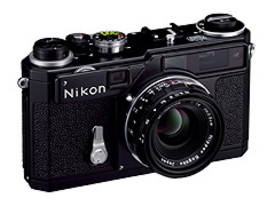Author Archives: Diego Rodriguez
metacool Thought of the Day
"To me, doing design doesn’t mean giving form to a more or less stupid product for a more or less sophisticated industry. Design for me is a way of discussing life, sociality, politics, food and even design."
– Ettore Sottsass
Building a Product Dynasty: Gran Turismo 4
Five simple steps to creating a product dynasty, a la Kazunori Yamauchi:
- Tap into your abiding love for cars and racing to create a vision of the best damn driving game/simulation around.
- Hire only programming maniacs and monster artists who share your extravagant automotive fetish.
- Do everything totally, massively, to the hilt.
- Ship the best damn game to market. See what works and what doesn’t, and take notes for future editions.
- Wait a few years, go back to Step 2 and repeat. Wait a few more years and repeat again. Let another presidential term slip by and repeat once more.
Today is one of those hallowed days that makes even this thirty-something professional giggle like a kid on Christmas morning. Why? Because today — today!! — the talented crew of Polyphony launches Gran Turismo 4, a tribute to focused vision, technical virtuosity, and the entrepreneurial moxie it takes to design every fractal element — from large to small — to the hilt.
Excuse me while I go flog my Toyota Celica WRC rally car through the snowy forests of Finland.
Expanding the Definition of Your Offering
Where does your offering start and end? Where should it start and end? What could you do at the borders of your existing offering to help it deliver a more delightful user experience?
The people behind the Everquest online fantasy video game asked themselves these questions and came up with something pretty special:
While playing EverQuest II just type /pizza
and a web browser will launch the online ordering section of
pizzahut.com. Fill in your info and just kick back until fresh pizza is
delivered straight to your door.
How cool is that? Pizza on demand isn’t a traditional video game feature like better graphics and more complex story lines, but it is an amazing way to enhance the video game experience. And it’s a good example of how customer-centric innovation doesn’t always need to be something big and scary. It might just be about asking the right questions.
Creating Cool Stuff with Storytelling, part 3
I’ve always worked in product development. It’s an intensely social environment where people are constantly telling each other stories to get their point across. Accordingly, I’ve probably sat through at least one PowerPoint presentation for each day I’ve spent in the office.
It’s often painful. So painful, in fact, that next time someone stands up in a meeting and begins reading directly off their PowerPoint prezo, I swear I’m going to every-so-politely inform them that the last person to read to me out loud was my mother and that procedure ceased circa 1974. Trust me, I can read, and if there’s some text around, I’d rather digest it myself than try to listen to you and read it myself at the same time.
Here’s the problem: PowerPoint wasn’t designed as a tool for documenting complex thoughts or piles of information. As a wise man once said, trains of thought need tracks. And those tracks are best constructed of prose, which is what Microsoft Word is for. So when people use PowerPoint as a medium for complex and complete sentences, tables, lists of bullets, etc… they’re not helping their story or their audience get to a good place.
Cliff Atkinson shows on his blog that removing text from PowerPoint improves both information retention and transfer. And I recall Seth Godin advising that we use no more than six or so words on any PowerPoint slide. Use a photo or drawing instead, he says. Removing text from your PowerPoint decks forces you to become an active storyteller, and that’s fine, because that’s what we humans do when we’re around one another.
So. Word = Prose Documentation. PowerPoint = Active Storytelling. If you need both outcomes, use each program to write up two different documents.
It’s Not About the Blog
Today Robert Scoble said something terribly trenchant about marketing:
"You should be fired if you do a marketing site without an RSS feed."
He’s right.
Really Simple Syndication (RSS) isn’t about blogs. It isn’t about geeking out and being a blogger, either. Forget blogs. RSS is about giving your customers the ability to say "Yes, I’d like to continue to hear what you’ve got to say." You’d have to be a total coward of a marketer not to try using a RSS feed (whether you call it a blog or not) to have a conversation with your customers. It’ll take a bit of work, and you’re going to have to put some writing and thoughts and feelings out into the public domain and maybe take a risk or two, but that’s life.
Good marketing takes guts.
Creating Cool Stuff with Storytelling, part 2
As a design thinker, I wouldn’t dream of embarking on a development project without first establishing my point of view (POV). Establishing and growing a POV is an integral part of my design process. Think of a POV as your take on why whatever you’re creating merits a place in the universe. What makes it remarkable?
As it turns out, establishing a strong POV has everything to do with good storytelling. For help in illustrating this idea, I direct you to the writing of Scott Rayburn, who is growing a tasty new blog around teaching great public speaking, and to some extent, storytelling. He insists that to create a good story, you need to understand your Big Idea:
First, wade through all the fact and figures and themes of a subject
and distill everything down to an idea that can be expressed in fewer
than 10 words.Next, shape your message around those 10 words… When your audience hears your presentation, what is it you want them to remember above all else?
So the concept of the Big Idea is to storytelling what POV is to design: don’t leave home without it. Now, I believe that to make your designs take hold in the world, you need to be a good storyteller. So it’s delightful to think that perhaps design thinkers already know the right process for designing — and telling — good stories.
Sound Matters, part 3
Do you care — really care — about expressing your brand as best you can?
The people at Nikon really care. They recently reissued their famed SP 35mm camera from 1957, and it’s incredible the length they went to make this new offering look, feel, and even sound like the brand-defining original.
How incredible? Well, Nikon engineers used computers to create a sonic "fingerprint" of the original and then fine-tuned the materials of the new SP to make it sound exactly the same. For example, rather than using modern titanium for the focal plane shutter, they chose to employ rubberized silk — the way things were circa 1957. This is an expensive design decision, not to be taken lightly. Assembly lines for this kind of shutter are way more expensive to run because the fabric precludes a modular, streamlined production flow, and demands a very tricky fine tuning of each unit. By the way, this is not the sort of thing they teach you at Harvard Business School. Can you imagine standing up in your next marketing meeting and saying "We’re going to go with this production method from the Eisenhower decade because it’s the best thing for our brand. Oh, and it costs a bundle and isn’t technically advanced, either."? It would be tough for me, too.
But it’s absolutely the right choice, because it makes the new SP sound right, and that’s worth everything here. Sound really does matter. How far would you go to make your brand sound the way it needs to sound?
Read Sound Matters & Sound Matters, part 2
thanks to Valentin Sama for the reference
Creating Cool Stuff with Storytelling
For a whole host of reasons, I’ve become obsessed with the idea that most of process of bringing cool stuff to life is about telling great stories. Great stories are a way to communicate a complex value proposition, evoke emotions, relate a new offering back to its brand, or to shape the Reflective elements of a design that create "brand" in the first place. And storytelling is a wonderful way — perhaps the only way — for innovators to convince key stakeholders, partners, and collaborators of the worth of their quest.
Storytelling holds the potential to take business thinking from the cold, dry left-brain world of 4P’s and 5C’s and 6 sigma to a warm, rich world of ethos and pathos. It’s about being human.
Example: when I was marketing QuickBooks Online, I had a helluva job on my hands: how do I convince really busy, really technology wary, really penny-wise small business people to adopt a non-sexy accounting software solution that requires the use of a scary new technology platform (the Internet) and a strange business/transaction model (software as service)? I spent months iterating my way to what, in retrospect, is an obvious solution: tell stories. And not just any stories, but stories told by users themselves, telling them in a "keep it real" kind of way. As you can see here, I created stories using raw, basic photos, and didn’t do anything to edit the verbatim words of my customers. Zilch, nada, nothing. In turn, these stories are compelling to prospective customers because they ring true, plain and simple. They’re good stories in a way that a traditional software industry white paper could never be.
This is why I can’t wait to start reading John Winsor’s book Beyond the Brand. On his blog he provides a nice excerpt which explains the key elements of compelling storytelling:
- Context
- Simplicity
- Interest
- Trust
- Meaning
- Connectedness
- Magic
- Relevance
- Immediacy
See the rest of his blog post here. I, for one, look forward to using his wisdom to enhance my ability to tell good stories.
Title Inflation: Do it to the hilt!
Seth Godin is blogging about English Cut’s bespoke suits. "In an era where you don’t have to wear a suit," says Seth, "a $3,000 suit is nothing but remarkable."
He has a point, but at a time where progressive organizations have dumped formal job titles, and where title inflation runs rampant in those companies where they’re still in use, to be truly remarkable one needs to go beyond mere Savile Row tailoring. No, in this era of the post-modern economy, to be well and truly remarkable demands nothing less than a good old fashioned peerage. If it’s clothes that make the man, it’s a royal title which makes The Man.
I’d quite fancy an org chart tag like Consignore Rodriguez.
Want to be remarkable? Why not do it to the hilt?
thanks to Alex for the tip


